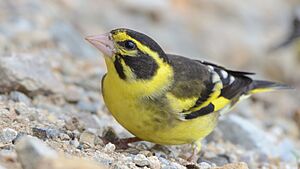Yellow-breasted greenfinch facts for kids
Quick facts for kids Yellow-breasted greenfinch |
|
|---|---|
 |
|
| Conservation status | |
| Scientific classification | |
| Genus: |
Chloris
|
| Species: |
spinoides
|
| Synonyms | |
|
Carduelis spinoides |
|
The yellow-breasted greenfinch (Chloris spinoides) is a small, colorful bird. It's a type of passerine bird, which means it's a perching bird. This little bird belongs to the Fringillidae family, also known as the finch family. You can find it living in the northern parts of the Indian subcontinent.
Contents
How Scientists Name This Bird (Taxonomy)
Scientists give every living thing a special two-part name. This helps everyone know exactly which plant or animal they are talking about. The yellow-breasted greenfinch was first described in 1831 by an Irish zoologist named Nicholas Aylward Vigors. He gave it the name Carduelis spinides.
Later, scientists used new methods to study birds. They looked closely at their DNA. These studies showed that greenfinches are not closely related to other birds in the Carduelis group. So, they were moved to a different group called Chloris. This group name was first used by a French naturalist, Georges Cuvier, way back in 1800.
The name Chloris comes from an old Greek word. It means "greenfinch." The second part of the name, spinoides, means "resembling a siskin." A siskin is another type of finch.
Different Types of Yellow-breasted Greenfinch
Scientists have found two main types, or subspecies, of the yellow-breasted greenfinch:
- Himalayan yellow-breasted greenfinch (C. s. spinoides) (Vigors, 1831) – You can find this type in Pakistan, the Himalayas, northeastern India, and southern Tibet.
- Indian yellow-breasted greenfinch (C. s. heinrichi) (Stresemann, 1940) – This type lives in northeastern India and western Myanmar.
What Does It Look Like?
The yellow-breasted greenfinch is a small bird. It is about 12 to 14 centimeters (about 5 inches) long. It weighs between 15 and 21 grams, which is about as much as a few quarters.
This bird has a brown, cone-shaped beak. Its wings have bright yellow stripes, which are easy to spot. The feathers on its belly and chest are also a bright yellow color. Both male and female birds look similar. However, the female's colors are usually a bit less bright than the male's.
Where Does It Live?
The yellow-breasted greenfinch mostly lives in the middle parts of the Himalayas. You can also find it in some areas of Southeast Asia. Its home range includes several countries. These are Afghanistan, Bhutan, India, Myanmar, Nepal, Thailand, Tibet, and Vietnam.
This bird likes to live in certain places. Its natural habitats are forests that have mild temperatures. It also enjoys living in areas with temperate shrubland, which are places with lots of bushes and small trees.



